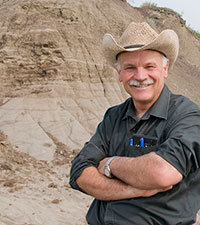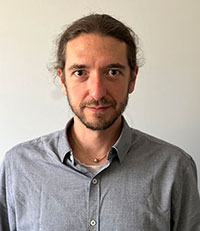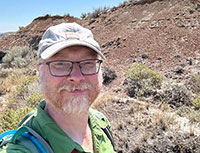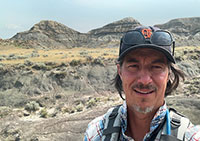 Donald B. Brinkman. Royal Tyrrell Museum of Palaeontology, Drumheller, Alberta, T0J 0Y0, Canada, and Adjunct professor, Department of Biological Sciences, University of Alberta, Edmonton, Alberta, Canada (corresponding author). Don.brinkman@gov.ab.ca
Donald B. Brinkman. Royal Tyrrell Museum of Palaeontology, Drumheller, Alberta, T0J 0Y0, Canada, and Adjunct professor, Department of Biological Sciences, University of Alberta, Edmonton, Alberta, Canada (corresponding author). Don.brinkman@gov.ab.ca
Donald Brinkman is Emeritus Curator and the Royal Tyrrell Museum of Palaeontology and Adjunct Professor at the Department of Biological Sciences at the University of Alberta in Edmonton, Alberta. He received his Bachelors of Science in Geology and Zoology at the University of Alberta in 1975 where he was introduced to vertebrate paleontology by Dr. R.C. Fox. He received his PhD at McGill University in 1979, studying under the supervision of Dr. R. Carroll. After graduating, he worked for three years as Curatorial Assistant to the Associated Curator of Vertebrate Paleontology at the Museum of Comparative Zoology in Harvard University. In 1982 he was hired as curator of vertebrate Paleontology at the Royal Tyrrell Museum of Palaeontology in Drumheller, Alberta, Canada. He research focused on the taxonomy, biostratigraphy, and distributions of Mesozoic turtles and the use of Cretaceous vertebrate microfossil assemblages for studies of paleoecology and distribution of vertebrates with a special emphasis on teleost fishes. He assumed the role of Director of Preservation and Research in 2008 and retired in 2018. After retirement he continued his association with the museum as Emeritus Curator, where he continues with research project.
![]()
 Julien D. Divay, Royal Tyrrell Museum of Palaeontology, Box 7500, Drumheller, AB, Canada, T0J 0Y0. jddivay@gmail.com
Julien D. Divay, Royal Tyrrell Museum of Palaeontology, Box 7500, Drumheller, AB, Canada, T0J 0Y0. jddivay@gmail.com
Dr. Julien D. Divay is a vertebrate palaeontologist based in Calgary. He currently serves as a Research Associate in Palaeoichthyology at the Royal Tyrrell Museum of Palaeontology and as an Early Career Assistant Editor for the Canadian Journal of Earth Sciences. After earning his undergraduate and master’s degrees in palaeontology from Liverpool John Moores University and the University of Bristol, he developed a strong interest in microvertebrate fossils. This led to a role as a Research Assistant at the Royal Tyrrell Museum and the completion of his Ph.D. at the University of Alberta.
Dr. Divay's research focuses on reconstructing North American ichthyofaunas and palaeoenvironments, with particular emphasis on understanding the impact of the Cretaceous–Paleogene mass extinction on freshwater fishes. He uses fossil material to identify periods of faunal turnover, provide calibration points for molecular studies, document palaeobiogeographical dispersal patterns, and trace the emergence of specific morphological features within evolutionary lineages.
![]()
 David G. DeMar, Jr. Burke Museum of Natural History and Culture, Seattle, Washington, 98195-1800, USA. ddemar@uw.edu
David G. DeMar, Jr. Burke Museum of Natural History and Culture, Seattle, Washington, 98195-1800, USA. ddemar@uw.edu
Dr. Dave DeMar is a vertebrate paleontologist who principally studies the evolution and systematics of lissamphibians (e.g., salamanders, frogs) and lepidosaurs (tuataras + lizards) from the Mesozoic and early Cenozoic and how they and other vertebrate groups faired during the end-Cretaceous mass extinction and subsequent faunal recovery. Dave received his PhD in Biology in 2016 from the University of Washington (UW) and later was a postdoctoral fellow at UW and in the Department of Paleobiology at the Smithsonian’s National Museum of Natural History (NMNH). Currently, he is the Hell Creek Project Collections Manager at the UW Burke Museum and a Research Associate at the Burke Museum and the NMNH. Dave has carried out paleontological field work in the USA (Montana, Wyoming, New Jersey, Maryland, Georgia) and abroad (Ethiopia, India).
![]()
 Gregory P. Wilson Mantilla. Department of Biology, University of Washington, Seattle, Washington, 98195-1800, USA and Burke Museum of Natural History and Culture, Seattle, Washington, 98195-1800, USA. gpwilson@uw.edu
Gregory P. Wilson Mantilla. Department of Biology, University of Washington, Seattle, Washington, 98195-1800, USA and Burke Museum of Natural History and Culture, Seattle, Washington, 98195-1800, USA. gpwilson@uw.edu
Dr. Gregory Wilson Mantilla is a Professor in the Department of Biology and a Curator of Vertebrate Paleontology at the Burke Museum at the University of Washington. He is also a Research Associate at the University of California Museum of Paleontology and was a Curator of Vertebrate Paleontology at the Denver Museum of Nature & Science. Greg attended Stanford University as an undergraduate and received his PhD in Integrative Biology from the University of California, Berkeley in 2004 and was an NSF Postdoctoral Fellow at the University of Helsinki in 2005. He has undertaken field work in various places, including India, Niger, Ethiopia, Colombia, Bolivia, and Montana. His research aims to understand critical transitions in the deep-time history of life. One of the most captivating of these transitions is the early radiation of mammals, which ultimately led to their striking diversity today, from the tiny, flying bumblebee bat to the titanic, fully aquatic blue whale. Work from his lab has elucidated paleoecological and macroevolutionary patterns of early mammals in the context of dinosaur-dominated terrestrial ecosystems, the breakup of Pangaea, and the mass extinction at the end of the Mesozoic (K/Pg).

